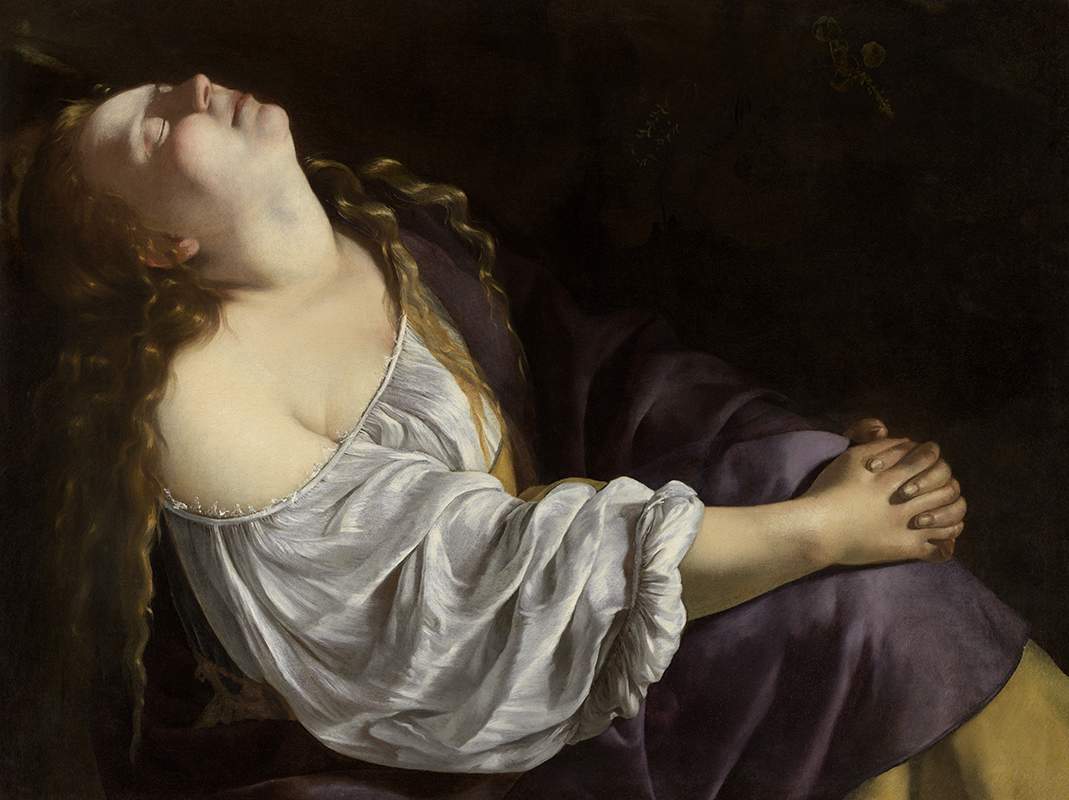A Magdalene by Artemisia Gentileschi arrives at the Doge's Palace in Venice: long-term loan
Starting June 11, the Doge’s Palace in Venice will host a work by Artemisia Gentileschi, marking the return of a heroine of art history and a distinguished artist to the lagoon. Indeed, in the Sala Quarantia Civil Vecchia comes Maria Maddalena in ecstasy, a work from a private collection that inaugurates the Ospiti a Palazzo exhibition and comes to the Doge’s Palace on long-term loan.
In the painting Mary Magdalene is not penitent, but in ecstasy, with her head tilted back and her eyes closed in mystical rapture. The light source from below adds to the intimate drama of the scene. Pose and face express a raw sensuality; that this subject was painted by a woman with such expressive intensity only increased its value in the eyes of collectors of the time; in our time it continues to exude a charm that captivates the contemporary viewer. The work comes to the Doge’s Palace following the exhibition Her Hand: Artemisia Gentileschi and Women Artists in Italy 1500-1800 in the Detroit Institute of Arts, which closed May 29.
The relationship between Venice and Artemisia Gentileschi has only become more clearly delineated in recent years. We now know that the painter stayed in the city for about three years, between 1626 and 1629, and of her presence and activity we are informed by testimonies traceable to academic and literary circles. Artemisia in Venice came into contact with some of the leading literary figures of the time, and her presence did not go unnoticed: many poets dedicated eloquent verses to her, admired her artistic temperament and involved her in their literary evenings. Among the many letters and poems dedicated to her are some verses included in a pamphlet given to print in 1627 by the Venetian publisher Andrea Muschio, in which three paintings by what is called a “Roman painter in Venetia” are mentioned
At the time of the artist’s stay in Venice, the painting Magdalene in Ecstasy had already been executed: critics agree for a dating to the first half of the 1620s, when Artemisia resided in Rome and was much sought after, her clients were princes and cardinals. The work thus seems to anticipate that renewed interest that during the seventeenth century in the Serenissima favored descriptions of ’exemplary’ women. Indeed, in 1633 that Gallery of Famous Women by Francesco Pona was published, in which in addition to Lucrezia, a subject Artemisia treated during her Venetian period, the figure of Mary Magdalene is investigated. It was probably during the Venetian period that the artist obtained one of her most prestigious commissions: the execution for Philip IV of Spain of the painting with the story of Hercules and Onphale, destined for the Alcázar in Madrid, residence of the Spanish royal family.
Educated in Rome under the aegis of her father Orazio, Artemisia Gentileschi matured an aesthetic awareness adherent to those contrasts of light and shadow typical of Caravaggio’s poetics, which is found in this painting marked by a rapid traversal of light, the subject of which seems to translate the fine discussions that were being held in the Venetian literary academies at the time. Indeed, a new way of understanding and representing women was taking shape, promoted not only by poets and men of letters, but also by the painters involved in those academic sodalities. Also grafted onto this terrain was the ambiguous representation of Magdalene offered in the Galeria by Giambattista Marino, a prince of seventeenth-century Italian poets in contact with various exponents of Venetian culture, published in 1619. The “holy sinner” was no longer understood only as the penitent who had abandoned worldly life following her happy conversion, but ample space was given to her beauty, whose splendor, which was expressed through a voluptuous valence, referred first and foremost to a spiritual magnificence. In line with this assumption, Magdalene is not depicted here as penitent and therefore suffering, but caught in the moment of ecstatic rapture, which is expressed in her recumbent head and barely noticeable smile.
For all information about the visit, the Ducal Palace website can be consulted.
Pictured is the work by Artemisia Gentileschi.
 |
| A Magdalene by Artemisia Gentileschi arrives at the Doge's Palace in Venice: long-term loan |
Warning: the translation into English of the original Italian article was created using automatic tools. We undertake to review all articles, but we do not guarantee the total absence of inaccuracies in the translation due to the program. You can find the original by clicking on the ITA button. If you find any mistake,please contact us.




























